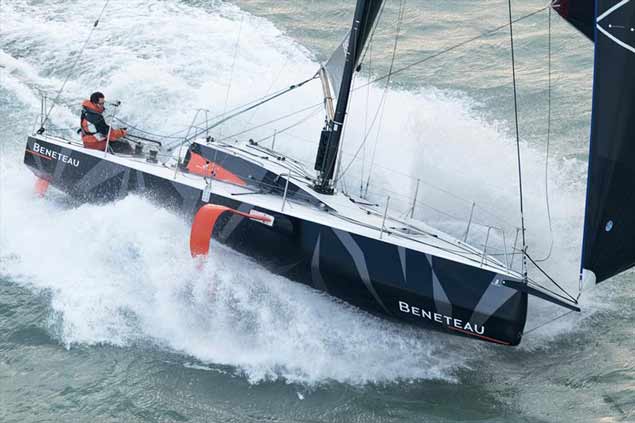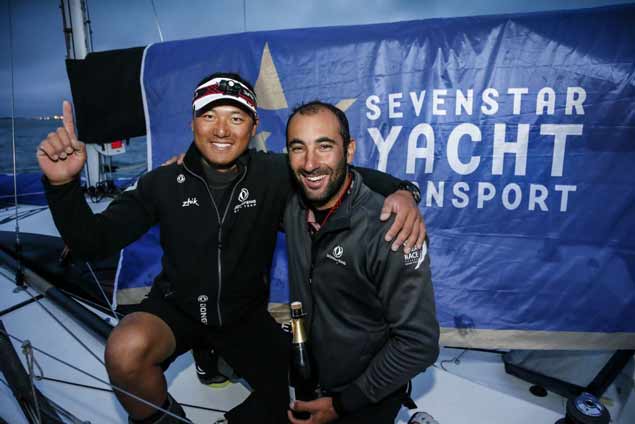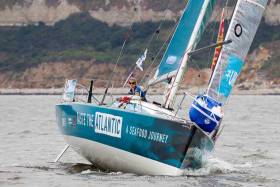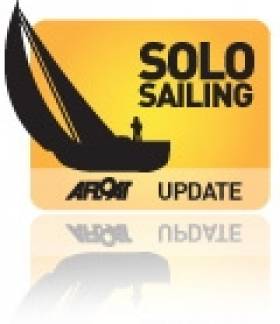Displaying items by tag: Figaro 2
Tom Dolan’s Beneteau Figaro 2 ( #15) (formerly “Smurfit Kappa”) is the second generation of the Beneteau Figaro series. She was designed by Lombard and built in 2004 by Beneteau. She was raced on the Figaro professional sailing circuit until 2018 when the Figaro 2 was replaced by the Beneteau Figaro 3, the third generation foiling vessel in the Figaro series.
The Figaro 2 is a superb 10.3 metre to sail. She has a large cockpit which is set up for single-handed sailing or crewed sailing. She is very well designed and has excellent directional stability up wind and down wind. She is very responsive and feels like a large SB20! She is an absolute pleasure to sail downwind with a spinnaker in 20 kts + of wind. She can be raced under IRC and has an IRC certificate. She is fitted out for racing where every gramme matters! She can be also fitted out for cruising should a new owner wish to do so.
She is well kitted out with a carbon mast, 4 winches, an auto pilot and a central NKE controller, AIS, 2 VHF’s ( one fixed and one portable), 1 EPIRB, 3 batteries, Radio/CD stereo, two suits of sails ( one set is 2018 Technique Voiles) , PC ( with MAXSEA software), Life Raft ( serviced in 2021), VOLVO 20 HP engine ( serviced in 2021). See web link below for full inventory.
The Figaro 2 (# 15) has a nice Irish link. It was the previous Figaro 2 raced by Tom Dolan, the Irish Professional Sailor who is based in France under the name “Smurfit Kappa”. He used her in the 2018 Professional French Sailing Federation Offshore Sailing. Since 2018 she has been lightly sailed mainly due to COVID. She had a thorough revision in 2020 by a professional workshop. She has been professionally maintained and is dry sailed. She is available to see at the Off Shore Sailing Centre in Lorient in South Brittany by appointment with Ronan Beirne the Broker at Network Yacht Brokers Dublin office. Tel 086 2543866.
For more information please visit Network Yacht Brokers Dublin office website here and enjoy this video of her starting the AG2R Transatlantic Race in 2018.
Solo Queen Figaro 2’s Farewell Tours Show Style & Quality
First unveiled in 2003 as the new boat for the 1970-founded Figaro Solo Series, the Marc Lombard-designed 34ft Figaro 2 is a class act writes W M Nixon. But with the last one built in 2015, and replacement by the foil-sporting Figaro 3 well underway for next year, the versatile Figaro 2’s days at the sharpest edge of offshore racing are numbered.
 The Figaro 3’s foiling configuration will become a full part of the Figaro Solo story in 2019
The Figaro 3’s foiling configuration will become a full part of the Figaro Solo story in 2019
Or are they? Though she carries a tough IRC rating, the Figaro 2 can sail up to it, as has been revealed in the RORC Sevenstar Round Britain and Ireland Race. The tail-enders in that boat-breaking marathon are still struggling in light winds towards the finish in the Solent. But in the two-handed division, Volvo Ocean race veterans Benjamin Schwartz and Chen Jin Hao with their Figaro 2 El Velosolex SL Energies Group are long since finished, and they’ve made quite a clean sweep of it – first in 2-handed, first in IRC 2, and 2nd in IRC Overall.
 Chen Jin Hao and Benjamin Schwartz after winning the Two-Handed Division and placing second overall in the RORC Sevenstar Round Britain and Ireland race.
Chen Jin Hao and Benjamin Schwartz after winning the Two-Handed Division and placing second overall in the RORC Sevenstar Round Britain and Ireland race.
This made it an event to remember for Marc Lombard, as he also designed Guy Redpath’s Lombard 46 Pata Negra which won IRC overall and is also rated as the line honours winner. For although Class 40 sailed the same course with Phil Sharp’s Imerys Energy first to finish of the entire fleet, as far as the RORC were concerned it was the IRC Divisions which were the real race, and they made Pata Negra (third in fleet) the recognised line honours victor.
That in turn made El Velosolex second in line honours, But even in the complete fleet with Class 40 included, she was fifth on the water across the finishing line, a brilliant performance by two hyper-tough guys with a now classic boat which happened to be the smallest in the fleet.
This very special boat comes centre stage again on Sunday, with her final time as the boat-of-choice for the staging of the four part URGO Figaro Solitaire from Le Havre, and we’ll be looking at the prospects for Irish skippers Joan Mulloy and Tom Dolan here very shortly. But for now, after the series is over, what then for the Figaro 2 after she has completed these impressive Farewell Tours??
Doubtless most of the boats have already been earmarked for new owners who will know they’re getting a bargain. Trouble is, in future seasons this will be a “No Excuses Sailing Machine”. In an open fleet against more ordinary craft, there’ll be no excuse for not doing well.
Solo Sailing Conference Offers Charter of Performance Yachts
Irish solo sailing fans may be interested in the annual Solo Racing Festival at the Royal Southern Yacht Club, Hamble on Saturday 12th March.
Given the Figaro race is coming to Dun Laoghaire in August a talk on the Artemis Academy with John Thorn (Figaro 2) will be of particular interest.
Owen Clarke's designer Merfyn Owen, who lives in Hamble will be attending as well as colleagues from their brokerage partners Boatshed Performance.
So whether your interest be solo sailing or short-handed sailing in general they will be there to answer questions on design, construction, as well as sale/purchase and charter of offshore performance yachts.
The Race Fair is an open house from 10.00 for race organisers to meet and greet potential skippers from; Global Ocean/Class 40, Mocra, UK mini group, RORC, SORC, Biscay Challenge, AZAB. Floating boat show, 8 boats including the OC class 40, 2 minis, A35, J105, Figaro 2, Sunfast 3200.
There is a Book Signing, Alex Bennett signing copies of High Seas High Stakes and showing Fuji DVD Mike Golding is opening the talks at 11,00.
Followed by:
Winning Mind Set with Ian Brown, sports psychologist
Global Ocean race with Oliver Dewar
Two Star/Ostar with John Lewis, RWYC
30m trimaran design with Nigel Irens (Idec, Sodebo)
Artemis Academy first term report with John Thorn (Figaro 2)
Route du Rhum with Marco Nannini, (class 40)
all in the spendid riverside setting of the Royal Southern Yacht Club, Hamble.
More HERE.

























































